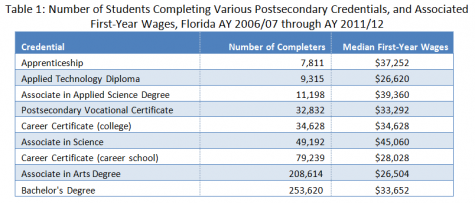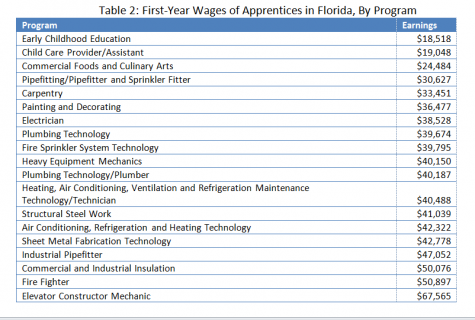Florida Numbers Show Not All Apprenticeships Are Equal
Apprenticeships—or to be more precise, the praise of apprenticeships—is everywhere. In his 2014 State of the Union address, President Obama called for expanded access to apprenticeships and has endorsed apprenticeships in other speeches. In mid-April, the President put resources behind that talk, unveiling a $100 million fund to support apprenticeship programs. The idea is that businesses, unions, community colleges or nonprofit organizations could form partnerships to teach skills for hard-to-fill jobs, including information technology, healthcare and advanced manufacturing.
Despite the pro-apprenticeship talk, nationwide, the number enrolled in apprenticeships is lower now than 10 years ago (288,000 today compared to 469,000 in 2002). And the number of people completing apprenticeships is also down, from 52,000 in 2002 to 44,000 today.
The White House says that 87 percent of apprentices get jobs after finishing their training programs, with an average starting salary, nationally, of more than $50,000 a year. If this is true, the small and declining numbers of students in apprenticeships is a terrible waste. Data from Florida confirm that apprenticeships are not widely used but the data also suggest that not all apprenticeships are created equal. [1]

[1] These data are for students enrolled in registered apprenticeship programs. While some apprenticeship programs may be offered directly by unions or employers, in Florida most programs use local technical schools or community colleges for the related classroom instruction. http://www.fldoe.org/academics/career-adult-edu/apprenticeship-programs/
Table 1 shows the number of students who completed various sub-baccalaureate credentials in Florida between the 2006/07 and the 2011/2012 academic years. Data for bachelor’s degrees, the most common undergraduate degree granted in Florida and the nation, are also included, as a comparison point. Verifying that apprenticeships are relatively infrequently used, only about 7,800 apprenticeships were completed during the five-year span, the lowest number of completers across all the credentials listed in Table 1.
One part of the new consensus about apprenticeships is also confirmed—completers can do quite well in the labor market. Note that the average first year wages for an apprenticeship total more than $37,000, the third highest behind the technically-oriented associate’s degrees in applied science and associate in science. And note that apprentices earn more than graduates with Bachelor’s degrees. While short of the $50,000 wages noted in the White House’s fact sheet, apprentices on average earn a solid wage.
Perhaps most important, as the rush to embrace apprenticeships unfolds, we need to remember that not all apprenticeships lead to equal outcomes. Table 2 shows the first-year wages of apprentices according by program completed (based on the federal government’s Classification of Instructional Programs).

[2] More information on the economic success of Florida graduates >>
Apprenticeship programs in early childhood education do not yield high pay; neither does an apprenticeship in culinary arts. On the other hand, apprentices in fields that keep things working (elevators, plumbing, pipes, HVAC systems) can yield salaries above $40,000 (only three of these programs meet the $50,000 salary cited in the White House fact sheet).
Apprenticeships are gathering steam in postsecondary education. And the data from Florida suggest that apprenticeships should be part of the mix of post-high school credentials. However, apprenticeship programs are small in number relative to most other postsecondary options.
The White House is careful to link the apprenticeship programs that it wants to encourage to fields such as information technology, high-tech services, health-care and advanced manufacturing. This is the right path. However, as the apprenticeship bandwagon gathers speed, we should be careful that the relatively low wages paid to completers of many apprenticeship programs are brought to light, so that prospective students don’t just enroll in any apprenticeship program because they heard everyone who completes an apprenticeship gets a high paying job.